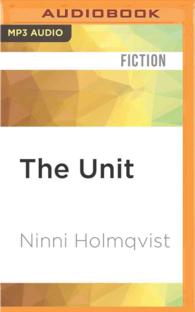Full Description
Showcases the best recent research on epigraphy across the medieval Islamic world
Explores Islamic epigraphy from a wide range of perspectives and geographical areas, from the Maghreb to India and Central Asia and beyond
Covers the period from the rise of Islam to the 15th century
Details 20 case studies of inscriptions found on a wide range of objects from coins, pen cases, textiles, tiles, pottery and wall paintings to public buildings, monuments, tombs, minarets, monasteries and madrasas
Beautifully illustrated with 200 colour photographs of inscriptions on buildings and objects
Includes contributions from some of the leading experts in the field including Jonathan Bloom, Robert Hillenbrand, Sheila Blair, Doris Behrens-Abouseif and Carole Hillenbrand
This volume offers an overview of the state of the field, and shows the importance of Islamic inscriptions for disciplines such as art history, history and literature. The chapters range from surveys to detailed exploration of individual topics, providing an insight to some of the most recent cutting-edge work on Islamic inscriptions. It focuses on the period from the rise of Islam to the fifteenth century, ranging across the Islamic world from the Maghreb to India and Central Asia, and inscriptions in Arabic, Persian and Turkish.
The five sections of the book draw together some of the principal themes: 'Royal Power' investigates the role of sultanic patronage in epigraphy, and the use of inscriptions for projecting royal power. 'Piety' examines the relationship between epigraphy and religious practice. 'Epigraphic Style and Function' explores the relationship between the use of specific epigraphic styles and scripts and the function of a monument. 'Inscribed Objects' moves from monumental inscriptions to those on objects such as ceramics and pen-cases. The final section considers the interplay between inscriptions and historical sources as well as the utility of inscriptions as historical sources.
Contents
1. Introduction Bernard O'Kane and A. C. S. Peacock
Part I: Inscriptions and Royal Power
2. The Fatimid Public Text Revisited Jonathan M. Bloom
3. Micro and Macro Power Projection in the Medieval Islamic World: The Architectural and Numismatic Epigraphic Evidence Richard P. McClary
4. The Monumental Inscriptions of the Great Seljuqs Malikshåh and Tutush. Observations on Texts, Protocols and Writing Styles Roberta Giunta
5. New Epigraphic Data from a Ghurid Monument at Chisht-i Sharif: Expressing Power and Piety in Sixth/Twelfth-Century Afghanistan Viola Allegranzi
Part II: Inscriptions and Piety
6. Stars and Symmetry: The Name of the Prophet Muhammad in Architectural Inscriptions Bernard O'Kane
7. Barakat Muhammad. Notes on Square Kufic Epigraphy in the History of Morocco Umberto Bongianino and Péter T. Nagy
8. Islamic Supplications of the Funerary Architecture of Medieval Castile Razan Francis
9. The Shaykh and the Amir: Reflections on the non-Quranic Epigraphic Programme in the Buildings of Shaykhi al-Umari al-NasiriNoha Abou-Khatwa
Part III: Inscriptions, History and Society
10. Tombstones from Aswan in the British Museum Venetia Porter
11. Marwanid Inscriptions Carole Hillenbrand
12. The Rise of New Epigraphic Languages in the Medieval Islamic East. The Interplay of Persian, Turkish and Arabic on Inscriptions A. C. S. Peacock
13. Inscriptions from the Golden Horde Period and the Crimean Khanate in Crimea: a Body of Hitherto Neglected Material within the Study of the Inscriptions of Islamic Lands Nicole Kançal-Ferrari and Fatma M. Şen
Part IV: Inscribed Objects
14. The Epigraphic Samarra Horizon: Blue-on-White Ceramics Rebecca Wrightson
15. Art with Poetry: Inscriptions on Mamluk Metalwork Doris Behrens-Abouseif
16. 'The Calligrapher is an Ape!' Arabic Epigrams on Pen Boxes (Sixth/Twelfth-Ninth/Fifteenth Centuries) Frédéric Bauden
17. Between the Artist and the Patron: Painted Inscriptions of the Khamsa of Shah Tahmasb Selin Ünlüönen
Part V: Epigraphic Style and Function
18. The Influence of Aesthetics on Orthographic Decisions in the Early Islamic Graffiti of Wadi al-Khirqa, Northern Hijaz Risa Tokunaga
19. The Here and the Hereafter: Rounded and AngularInscriptions in Medieval Syria, Anatolia and the Jazira Scott Redford
20. Luted Letters: The Relief Inscriptions on Kashan Lustre Mihrabs Sheila Blair
21. Carved Letters, Designs and Ornaments: Ilkhanid Stuccos and 'Signatures' of their Craftsmen Ana Marija Grbanovic
22. The Qutb Minar: Epigraphic Notes Robert Hillenbrand
Index








